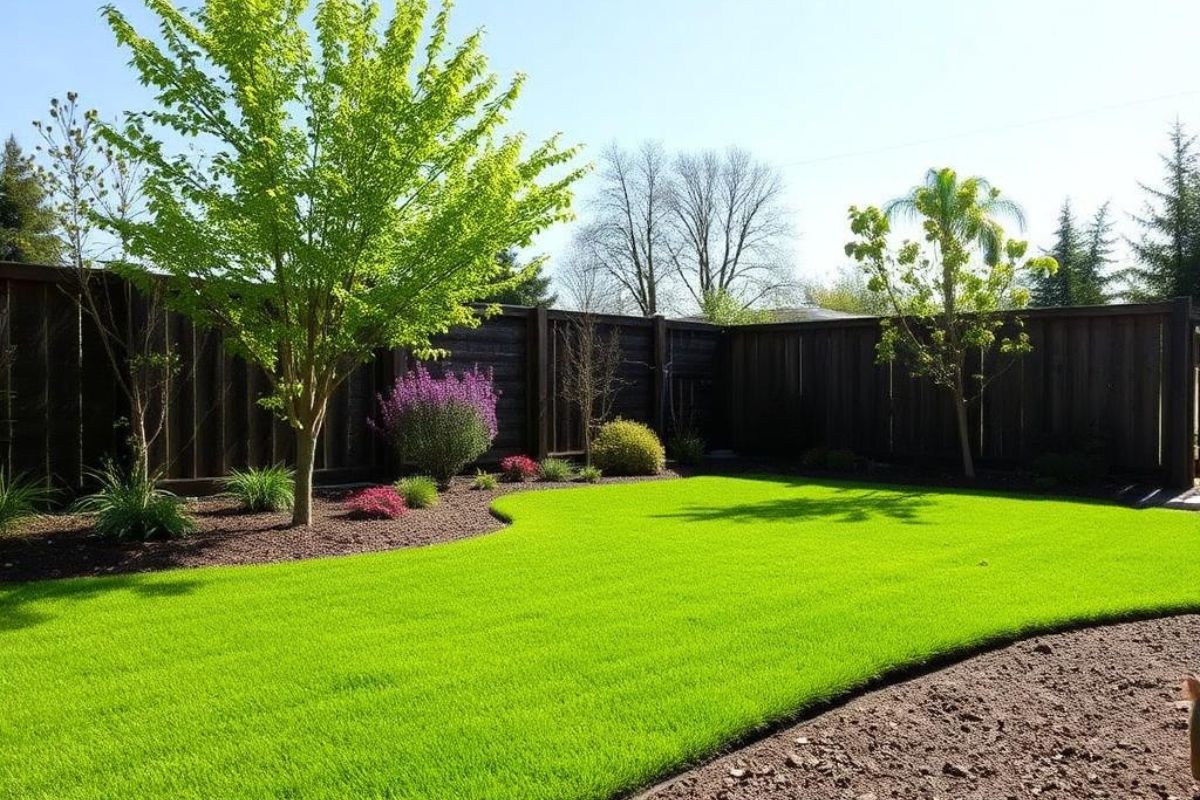How Deep Should I Dig to Lay Sod? Expert Lawn Tips
.jpg)
To lay sod effectively, you should dig 4 to 6 inches deep. This depth allows for proper root establishment and enhances soil aeration. Start by clearing debris and loosening the topsoil to create a healthy foundation. If your soil is compacted, deeper digging might be needed. After leveling, you're set for sod installation. Remember, a well-prepared area leads to a vibrant lawn. Want to know more about the best practices for laying sod?
- Dig 4 to 6 inches deep to establish a solid foundation for sod roots.
- Ensure soil is loosened and aerated for optimal root growth.
- Remove debris and level the surface to prevent water pooling.
- Address compacted soil by digging deeper if necessary for better drainage.
- A proper digging depth is crucial for a healthy lawn and vibrant growth.
Understanding the Importance of Soil Preparation
When you’re planning to lay sod, understanding the importance of soil preparation can't be overlooked. Proper soil prep sets the foundation for a lush, healthy lawn. Start by clearing the area of debris, rocks, and old grass. This guarantees the sod has direct contact with the soil, promoting better root growth. Next, loosen the top 3 to 4 inches of soil using a tiller or garden fork. This aeration improves drainage and nutrient absorption. Incorporate organic matter like compost to enhance soil fertility. Don’t forget to level the surface; uneven ground can lead to water pooling. By investing time in soil preparation, you’re giving your sod the best chance to thrive, ultimately creating a vibrant and resilient lawn.
Assessing Your Current Soil Conditions
Before laying sod, it’s essential to assess your current soil conditions to guarantee ideal growth. Start by checking the soil type—whether it’s sandy, clay, or loamy—as this influences drainage and nutrient retention. Next, dig a small hole about 6 inches deep to evaluate soil texture and moisture levels. If the soil's compacted, it may inhibit root growth, so you’ll need to amend it. Also, test the pH level; most grasses thrive in a pH range of 6.0 to 7.0. Look for any debris, like rocks or roots, that might hinder sod installation. Finally, consider any existing weeds, as they can compete with your new sod for nutrients. Understanding these conditions will set you up for success!
Recommended Depth for Laying Sod
Once you’ve assessed your soil conditions, it’s time to determine the right depth for laying sod. Generally, you’ll want to dig about 4 to 6 inches deep. This depth allows for proper root establishment, guaranteeing your sod thrives in its new environment. If your soil is compacted, consider digging deeper to break through any hard layers.
After digging, level the soil and remove any debris like rocks or roots. This guarantees a smooth surface for your sod, which helps water penetrate effectively. Remember, the goal is to create a healthy foundation for your new lawn. Getting the depth right is vital for a lush, vibrant yard, so take your time and do it right the first time!
Tools You’ll Need for Digging
To tackle the task of digging for sod effectively, having the right tools is essential. Start with a sturdy shovel; a flat-edged shovel works wonders for cutting through grass and soil. A garden fork can help break up compacted earth, making it easier to dig. Don’t forget a rake for leveling the surface after you’ve cleared the area. If you’re dealing with tough soil, consider using a pickaxe or mattock to loosen it up. Gloves are a must to protect your hands from blisters and sharp objects. Finally, a tape measure will help guarantee you’re digging to the correct depth. With these tools in hand, you’ll be well-equipped to prepare your lawn for beautiful sod.
Steps to Clear the Area Before Laying Sod
Having gathered your tools, you’re ready to clear the area where you’ll be laying sod. Start by removing any existing grass or weeds; a sod cutter or shovel works well for this. Make certain to dig deep enough to eliminate roots that could regrow. Next, clear away rocks, sticks, and debris to create a smooth surface. If you’re working near trees, be cautious of any exposed roots. After that, level the soil using a rake, filling in any low spots to guarantee even drainage. Finally, use a roller or your feet to compact the soil lightly, preventing any sinking once the sod is laid. With a clean, prepared area, you’re set for the next step!
Amending Soil for Optimal Growth
Before laying down sod, amending the soil is essential for ensuring your new lawn thrives. Start by testing your soil's pH and nutrient levels; you can find kits at garden centers. If your soil's too acidic, add lime, and if it's alkaline, incorporate sulfur. Next, enrich the soil with organic matter like compost or well-rotted manure. This improves nutrient content and promotes beneficial microbial activity. Aerating the soil also helps increase oxygen flow, which encourages root growth. Be sure to mix these amendments well into the top 4 to 6 inches of soil. Finally, level the area to create a smooth surface, which will give your sod the best chance to establish itself quickly and effectively.

The Role of Drainage in Soil Depth
Once you've amended your soil for maximum growth, it's essential to contemplate the role of drainage in determining how deep to dig before laying sod. Proper drainage prevents water from pooling, which can suffocate roots and foster disease. If your soil retains too much moisture, consider digging deeper to create a drainage layer, allowing excess water to escape.
On the flip side, if you have sandy soil, you might not need to dig as deep, as it typically drains well. Evaluate your soil type and drainage conditions, and adjust your digging depth accordingly. This guarantees your sod has the right environment to establish strong roots and thrive, ultimately leading to a lush, healthy lawn.
Best Practices for Installing Sod
Installing sod can transform your yard into a vibrant green space, but following best practices is essential for success. Start by preparing your soil; clear away debris and weeds, then loosen the top 2-3 inches. Level the area for a smooth, even surface. Lay the sod in a staggered pattern, similar to bricks, ensuring seams don’t align. Press the edges together firmly to eliminate gaps. Water your new sod immediately after installation, soaking it thoroughly to encourage root growth. For the first few weeks, keep the sod consistently moist, but avoid overwatering. Finally, avoid walking on your new lawn until it establishes roots, usually around two weeks. With these steps, you’ll promote healthy growth and a lush, green lawn.
Maintaining Your New Lawn After Sod Installation
As you settle into the excitement of your new lawn, maintaining it properly is essential for ensuring its long-term health and beauty. Begin by watering your sod daily for the first two weeks, keeping the soil consistently moist but not soggy. After that, reduce watering to two or three times a week. Mow your lawn once it reaches about 3 inches high, but avoid cutting more than one-third of the grass height at a time. Fertilize your sod about six to eight weeks after installation with a balanced fertilizer. Finally, keep an eye out for weeds and pests, addressing issues promptly to prevent damage. With a little care, your new lawn will flourish beautifully!
Conclusion
In conclusion, preparing the soil properly is key to a thriving lawn. Aim for a depth of about 4 to 6 inches when digging to guarantee your sod has the best chance to root. Don’t forget to assess your soil quality and make necessary amendments. With the right tools and techniques, you’ll set the stage for a lush, green yard. Once your sod is installed, proper maintenance will help keep it healthy and vibrant for years to come!









